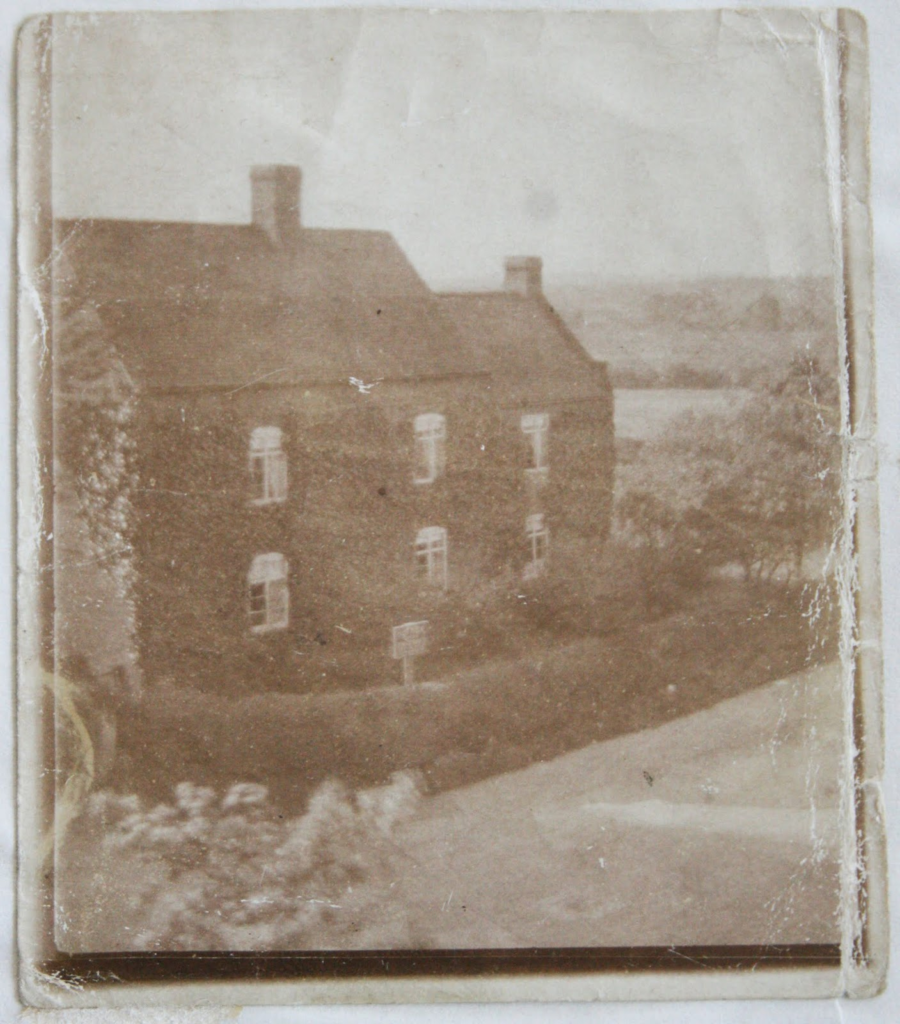
AT ROWHEATH, BOURNVILLE’. Probably dating from the 1930s or 1940s.
Today, Rowheath is a community-based organisation set around Rowheath Pavilion Church. At the centre is the Rowheath Pavilion building surrounded by green space and sports facilities, opened in July 1924. Before the area around became built up, Rowheath was a piece of farmland between Rowheath Farm, the farm building situated on Oak Farm Road, and Haygreen Farm, on Haygreen Lane. The Rowheath land had an old public footway running north-east through it, which later became Heath Road, and another running north-west, which still forms the main route through the playing fields. These were likely very old walkways through the land (map 1, below).
The name Rowheath itself possibly came from the ancient word ruh meaning rough or uncultivated, making it better land for grazing cattle such as cows, and Rowheath Farm seems to have predominantly been run as a dairy farm.[*1]
At the rear of Rowheath Farm was a marshy pool, possibly mentioned in a charter of AD 699, which was signed by Offa (Offa was a King of Mercia, Mercia being one of the Anglo-Saxon kingdoms). The charter described the route of a boundary passing through this area, and mentioned ‘spa thaet cume in Usan Mere’ [then it comes to Usan Pool].[*1] This marshy pool later became the fishing pond which still exists in the Pavilion gardens today (maps, below).



Rowheath Farm

There are still remnants of Rowheath Farm which survived. The farmhouse (pictured above) was knocked down, but part of the old barn buildings survive on Oak Farm Road which have been converted into houses. You can still see these as you walk around the area.
Rowheath Farm was originally part of the parish of Northfield until parish borders changed in about the 1920s, and it became part of the parish of Kings Norton. Parishes were administrative districts which had a church at their centre.

In 1810, the tenant of Rowheath Farm was Robert Cotterell, whose tenancy ran out in 1813 (see newspaper clipping, above).

The whole area was rural at this time, and some of the changes which cleared the way for the suburban village we have today are seen in the removal of 78 oak trees (see newspaper clipping, above).
The Grigg Family at Rowheath Farm

With thanks to a descendant of the Grigg family.
After the time of Mr. Cotterell the farm was run by the Grigg family, passing through three generations, the last generation retiring in 1918.
The first Grigg tenants were Samuel and Jemima Grigg. They moved to Northfield in or before 1819, but although they were probably living at Rowheath Farm from this time, it cannot be proven through historical evidence until 1841 when the first census was taken. Censuses listed people in their homes, and Samuel and Jemima were listed at the farm, already in their 60s by this time.
Samuel and Jemima had seven known children, the youngest son being another Samuel. Samuel senior passed away in 1857 and Samuel Junior took over the farm. He had married Martha Moss in 1850 and lived with his new bride in Stirchley, working as a farmer, before taking over from his father.[*2]
Martha passed away in 1898 and Samuel in 1904, and after this their two youngest children William and Lucy, both unmarried, took on Rowheath Farm. The photograph (see above) shows the farmhouse with William Grigg outside. William retired from farming in 1918 with descendants of the family stating that it was no longer making money possibly due to the war.6 William was 64 and his sister, Lucy, about 61.

With thanks to a descendant of the Grigg family.
After William Grigg retired, the then 130-acre farm was purchased on 29 October 1918 for £13,000 by Bournville Village Trust and the Cadbury Firm.[*3]
Becoming Rowheath Pavillion

AT ROWHEATH, BOURNVILLE’. Probably dating from the 1930s or 1940s.
The farm and farmland were purchased on the behest of George Cadbury with the intention of creating grounds for a variety of sporting activities. The Pavilion was built to supply the need for a clubhouse and changing rooms, and the garden and pool of the Pavilion was landscaped for leisure activities. The site was opened in July 1924.
In the 1930s Rowheath Playing Fields spread over about seventy-five acres, and included “eleven grounds for association football, three for rugby and seven for hockey, eleven cricket pitches, three bowling-greens, two croquet lawns, and forty-one lawn tennis courts. But not only is provision made at Rowheath for the out-and-out athlete; for the benefit of others there is a Garden Club, occupying nine acres, where there is a pavilion, together with gardens, shrubberies, ornamental waters (used by the Works Model Yacht Club), and facilities for playing gentler games as clock-golf, bowls, and croquet. A shallow pool is provided on which children may sail their boats”.[*3] The ‘shallow pool’ was probably the smaller pool on the other side of the bridge in the grounds today.

At this time, a groundsman was paid to look after the whole Rowheath estate, and his home was the old Rowheath Farmhouse.
References
[*1] Bill Dargue, ‘Row Heath’ from A History of Birmingham Places & Placenames.
[*2] Grigg family history is on WikiTree.
[*3) Iola A. Williams, The Firm of Cadbury 1831-1931 (London: Constable and Co. Ltd., 1931).